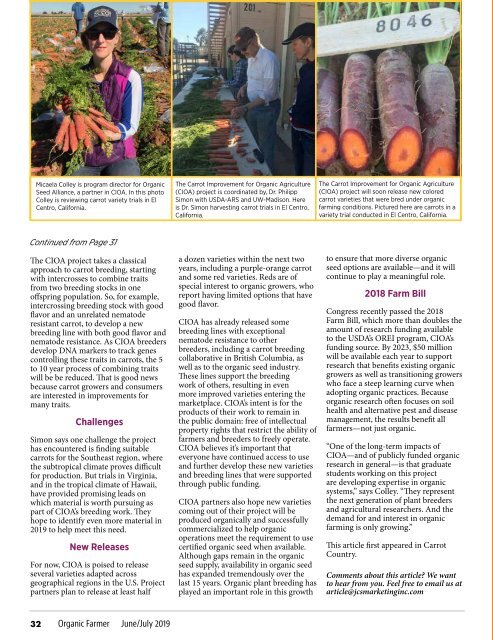Organic Farmer June 2019
Create successful ePaper yourself
Turn your PDF publications into a flip-book with our unique Google optimized e-Paper software.
Micaela Colley is program director for <strong>Organic</strong><br />
Seed Alliance, a partner in CIOA. In this photo<br />
Colley is reviewing carrot variety trials in El<br />
Centro, California.<br />
The Carrot Improvement for <strong>Organic</strong> Agriculture<br />
(CIOA) project is coordinated by, Dr. Philipp<br />
Simon with USDA-ARS and UW-Madison. Here<br />
is Dr. Simon harvesting carrot trials in El Centro,<br />
California.<br />
The Carrot Improvement for <strong>Organic</strong> Agriculture<br />
(CIOA) project will soon release new colored<br />
carrot varieties that were bred under organic<br />
farming conditions. Pictured here are carrots in a<br />
variety trial conducted in El Centro, California.<br />
Continued from Page 31<br />
The CIOA project takes a classical<br />
approach to carrot breeding, starting<br />
with intercrosses to combine traits<br />
from two breeding stocks in one<br />
offspring population. So, for example,<br />
intercrossing breeding stock with good<br />
flavor and an unrelated nematode<br />
resistant carrot, to develop a new<br />
breeding line with both good flavor and<br />
nematode resistance. As CIOA breeders<br />
develop DNA markers to track genes<br />
controlling these traits in carrots, the 5<br />
to 10 year process of combining traits<br />
will be be reduced. That is good news<br />
because carrot growers and consumers<br />
are interested in improvements for<br />
many traits.<br />
Challenges<br />
Simon says one challenge the project<br />
has encountered is finding suitable<br />
carrots for the Southeast region, where<br />
the subtropical climate proves difficult<br />
for production. But trials in Virginia,<br />
and in the tropical climate of Hawaii,<br />
have provided promising leads on<br />
which material is worth pursuing as<br />
part of CIOA’s breeding work. They<br />
hope to identify even more material in<br />
<strong>2019</strong> to help meet this need.<br />
New Releases<br />
For now, CIOA is poised to release<br />
several varieties adapted across<br />
geographical regions in the U.S. Project<br />
partners plan to release at least half<br />
a dozen varieties within the next two<br />
years, including a purple-orange carrot<br />
and some red varieties. Reds are of<br />
special interest to organic growers, who<br />
report having limited options that have<br />
good flavor.<br />
CIOA has already released some<br />
breeding lines with exceptional<br />
nematode resistance to other<br />
breeders, including a carrot breeding<br />
collaborative in British Columbia, as<br />
well as to the organic seed industry.<br />
These lines support the breeding<br />
work of others, resulting in even<br />
more improved varieties entering the<br />
marketplace. CIOA’s intent is for the<br />
products of their work to remain in<br />
the public domain: free of intellectual<br />
property rights that restrict the ability of<br />
farmers and breeders to freely operate.<br />
CIOA believes it’s important that<br />
everyone have continued access to use<br />
and further develop these new varieties<br />
and breeding lines that were supported<br />
through public funding.<br />
CIOA partners also hope new varieties<br />
coming out of their project will be<br />
produced organically and successfully<br />
commercialized to help organic<br />
operations meet the requirement to use<br />
certified organic seed when available.<br />
Although gaps remain in the organic<br />
seed supply, availability in organic seed<br />
has expanded tremendously over the<br />
last 15 years. <strong>Organic</strong> plant breeding has<br />
played an important role in this growth<br />
to ensure that more diverse organic<br />
seed options are available—and it will<br />
continue to play a meaningful role.<br />
2018 Farm Bill<br />
Congress recently passed the 2018<br />
Farm Bill, which more than doubles the<br />
amount of research funding available<br />
to the USDA’s OREI program, CIOA’s<br />
funding source. By 2023, $50 million<br />
will be available each year to support<br />
research that benefits existing organic<br />
growers as well as transitioning growers<br />
who face a steep learning curve when<br />
adopting organic practices. Because<br />
organic research often focuses on soil<br />
health and alternative pest and disease<br />
management, the results benefit all<br />
farmers—not just organic.<br />
“One of the long-term impacts of<br />
CIOA—and of publicly funded organic<br />
research in general—is that graduate<br />
students working on this project<br />
are developing expertise in organic<br />
systems,” says Colley. “They represent<br />
the next generation of plant breeders<br />
and agricultural researchers. And the<br />
demand for and interest in organic<br />
farming is only growing.”<br />
This article first appeared in Carrot<br />
Country.<br />
Comments about this article? We want<br />
to hear from you. Feel free to email us at<br />
article@jcsmarketinginc.com<br />
32<br />
<strong>Organic</strong> <strong>Farmer</strong> <strong>June</strong>/July <strong>2019</strong>


















